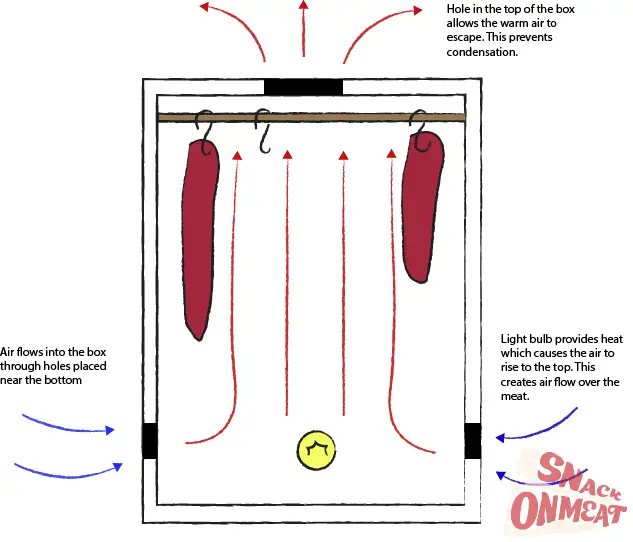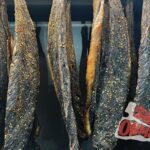There is a lot of information out there, some more reliable than others! Whether it’s from a friend or a Reddit forum, it can be hard to decipher what is true and what is nonsense. Similarly, regarding biltong, there is a lot of misinformation and people who like to over-complicate things. One topic always under dispute is whether biltong needs heat to dry.
The simple answer is biltong does not need heat to dry as it is air-dried meat; it is not cooked with heat. The complex answer is that if your outside humidity is 50% plus, you will need to add heat to the drying process. Notably, the purpose of adding heat is to dry the air and provide a convection current…Not to cook the meat in any way.
Drying the air will remove or lower humidity, which prevents condensation and moisture-causing mould. Heat also creates an air current (as everyone knows, hot air rises) that pulls air out and over the meat.
As biltong dries, water is drawn out from the centre and to the surrounding air. This air must be constantly extracted or moved over the biltong; so it doesn’t “hang around” and grow mould.
The takeaway is that the biltong drying process relies solely on airflow.
Therefore, if your drying conditions are cool (below 20c), with efficient airflow, the meat will still dry effectively (It will take longer than drying with warmer ambient temperatures). Accordingly, adding a fan to extract air from your biltong box is the priority before considering adding heat.
After the fact that biltong doesn’t need heat to dry, there is still an ideal temperature range to dry biltong. So let’s discuss how you can replicate the ideal conditions for drying biltong and the best heat sources to choose from.

Do I Need To Add Heat?
Out in the South African plains, the early Dutch settlers began preserving meat for their explorations. They found ideal conditions for drying meat in the cool and dry temperatures of Winter. We still seek delicious biltong in modern times, except most of us lack the natural environment.
The mission is to replicate the drying conditions that worked so well all those years ago. Unfortunately, making biltong has become complicated with so many opinions and ideas. One debate is whether biltong “needs” heat to dry. The facts are these; biltong does not need heat to dry, only continuous airflow.
There are cases when a small heat source is needed to warm the air, but this is never to cook the meat. A heat source is necessary when the air is humid and lacks airflow.
If you have a very cold or overly humid climate (over 55%), you will benefit from adding heat to the drying process. In most situations, the installation of a fan should be considered, before adding heat.
The foremost reason for installing an extractor fan before adding a heat source is to prevent case hardening. Case hardening is a situation that occurs when the outside of the meat cooks slightly or hardens. This is a terrible predicament as the moisture cannot escape from the centre, resulting in a raw centre and an unhygienic mess.
Biltong Brainiac: Test Your Dried Meat IQ

How Does A Heat Source Remove Humidity And Create Airflow?
First and foremost, humidity is Biltong’s greatest enemy! Biltong dried in humid conditions is the perfect predicament for mould to grow…”So why does humidity cause mould? And how does warming the air prevent it?”
Humid conditions occur in cold climates (below 20c) and hot ones (above 35c) due to the air holding a lot of moisture. For biltong to dry, the moisture from the centre of the meat must evaporate.
It then needs to be pulled away from the meat’s surface. If the air is moist, the evaporation from the meat will sit on the outside and grow mould. Moreover, condensation will occur inside the biltong box, increasing the humid conditions.
To combat humidity, you need to dry the air and create airflow. The small heat source will dry the air effectively, which removes the dampness. It will also cause a convection cycle where the warm air rises and pulls air over the meat. The air comes in, is warmed, and extracted by a fan at the top of the box.
A fan is an option as the air will naturally escape through the top of the box, but I highly recommend it as it speeds up the process and inhibits any stagnant air hanging around.

Ways To Add Heat
You typically add a heat source to the lower part of a biltong dryer (such as a biltong box). The heat source location allows air from the side vents to be warmed, which then rises and leaves through the top of the box.
A heat source should not be placed at the top of the box as this is counterintuitive to the general purpose of airflow. A heat source can be attached to the box walls, as this would still create a convection current as the cool air is pulled in, heated and then extracted over the meat.
There are several types of heat sources you can choose to add to your drying process. Your choice will depend on the drying enclosure or system you use. It will also depend on your budget! Here are the most common and simple means of adding a heat source to your biltong dryer. (Also here is an article about making biltong on a budget).
Light bulb
A 40-watt incandescent bulb (not LED) is the most simple and cheap way to add heat to your biltong dryer.
(Remember, biltong is supposed to be simple!)
You will find that most bought biltong boxes come equipped with one, and most “how to make a biltong dryer“ videos tell you to add one.
If adding a light bulb, you must place it at or just above the air vents at the bottom of the box. The light bulb will heat the air entering, causing it to rise and resultingly in pulling more air into the box.
It is becoming difficult to source incandescent bulbs with a preference for LEDs. If you cannot find one at a hardware store (Bunnings if you’re in Aus) or a grocery store, you will need to buy one online.
Make sure to choose a 40-watt bulb as you want the air slightly warmed, not hot.

Heat mat
Adding a heat mat is less common but is a safe option as it provides low uniform heat and is insulated. Although you most likely won’t start a fire with your 40-watt bulb, it will be less likely with a heat mat.
This option is more expensive than a lightbulb with the same results. But perhaps you already have one and would like to be different to the rest.

Golden Rod Dehumidifier
A rod dehumidifier is an expensive heating option, but, in my opinion, super cool! Golden Rods remove humidity and prevent rust in safes where expensive items are kept for long periods. It works by increasing the air temperature inside the safe or enclosure. This allows the warm air to circulate throughout the safe continually, thus eliminating humidity, mildew, and condensation.
Other Options
If you are drying your biltong in a room (e.g. in your kitchen) and need to remove humidity, you could install a dehumidifier to remove moisture from the air. Also, adding a fan to blow gently over the meat will help in this situation. If you are drying biltong in a cold area without airflow, there is also the option to warm the air with a small heater such as a portable oil heater.
In conclusion, while biltong does not require heat for drying, the addition of heat to the drying process becomes necessary in environments with high humidity. This is to facilitate air drying and create a convection current, rather than to cook the meat. So now you know the true answer, it’s time to go out and perfect your biltong whether you have a South African climate or a humid subtropical one.
Latest Posts:
- The Truth About Beef Jerky And Your Health
 A favourite among outdoor enthusiasts for its transportability, for fitness enthusiasts for its high protein content, and for those …
A favourite among outdoor enthusiasts for its transportability, for fitness enthusiasts for its high protein content, and for those … - Kangaroo Biltong: How To Make It
 We all know beef, game, and ostrich are the most traditional meats used for biltong, yet there’s an intriguing …
We all know beef, game, and ostrich are the most traditional meats used for biltong, yet there’s an intriguing … - What Is Biltong? Everything You Need To Know
 In the world of savoury snacks, one delicacy stands out for its unique flavour profile and rich history – …
In the world of savoury snacks, one delicacy stands out for its unique flavour profile and rich history – …






